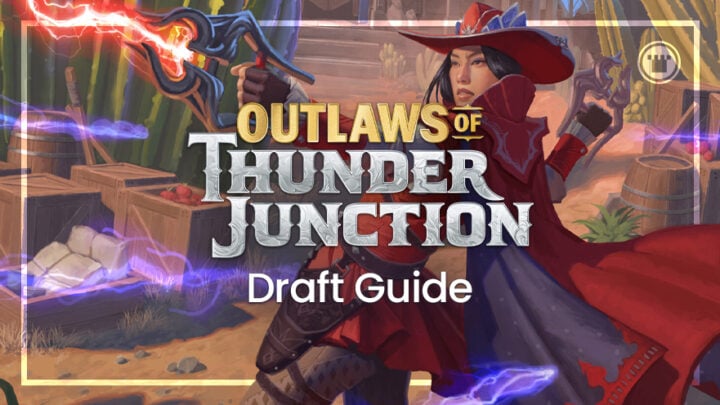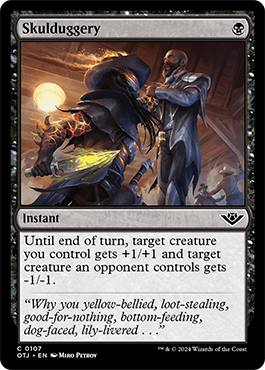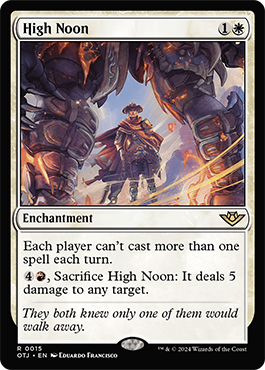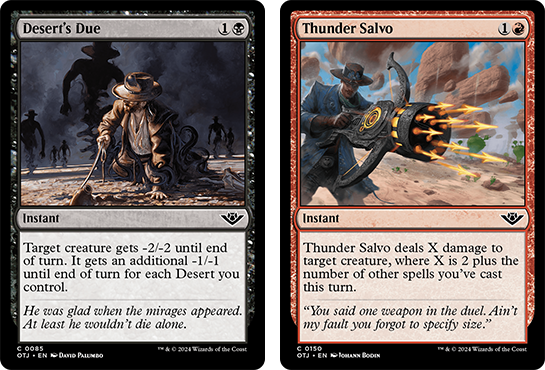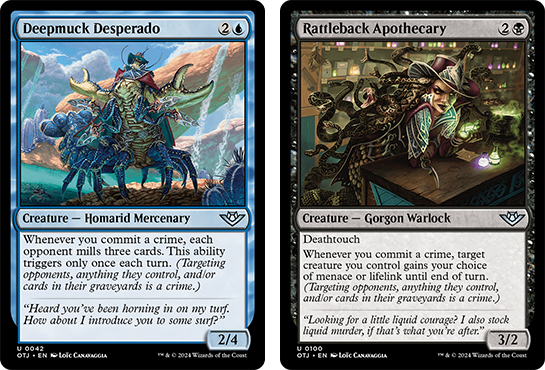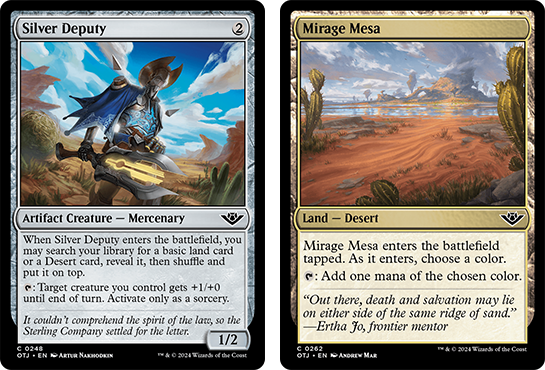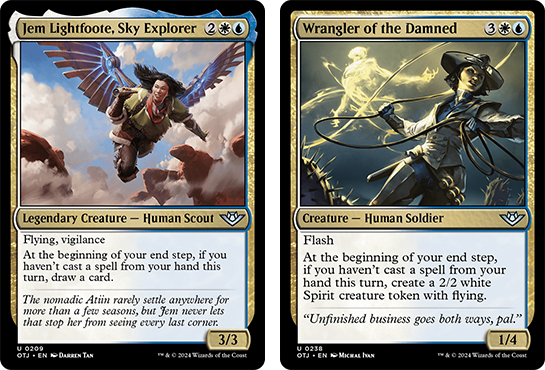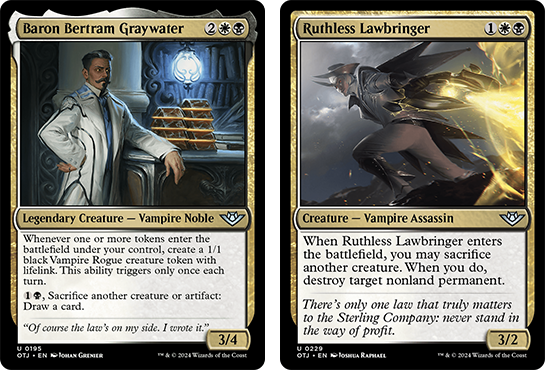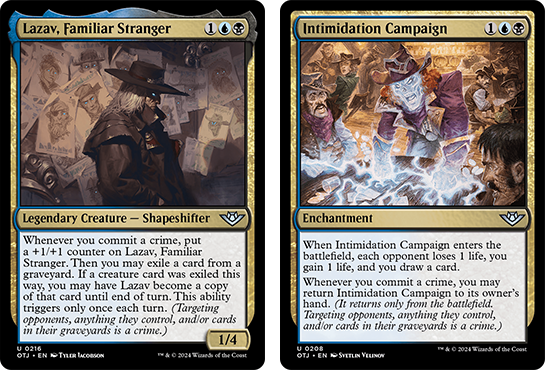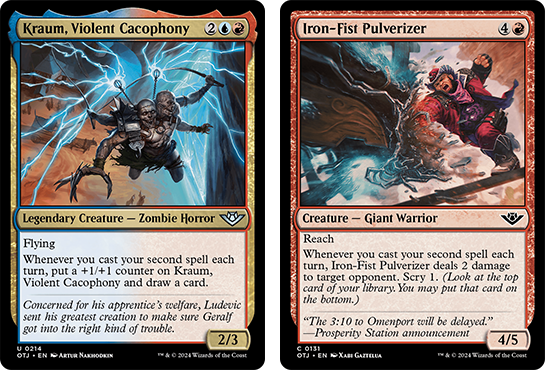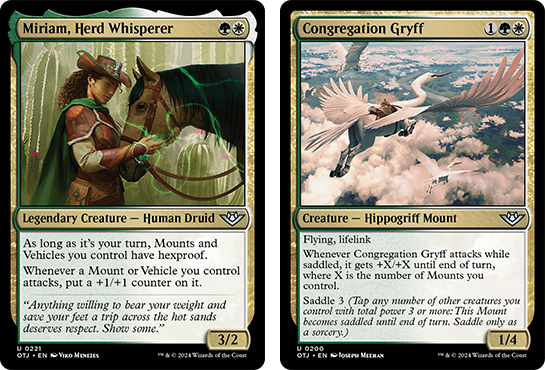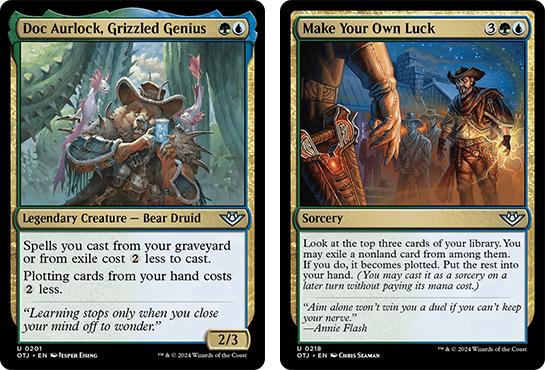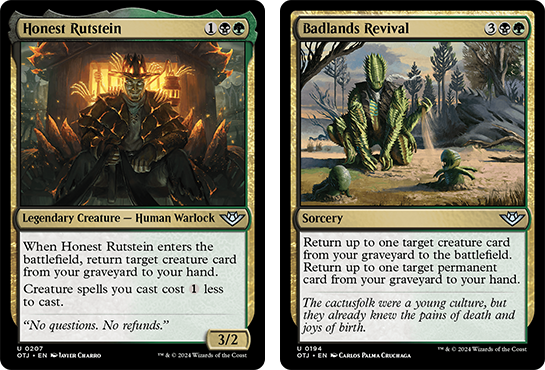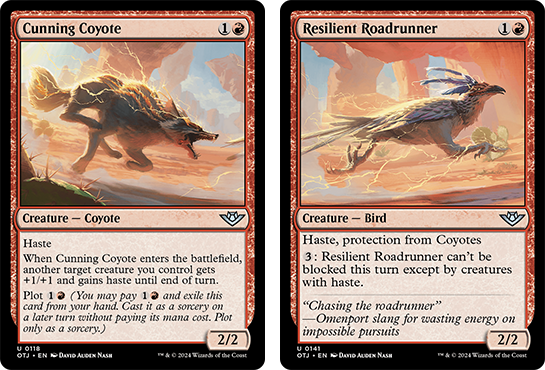Alright listen up, you low-down, snake-bit, cattle-rustlin’, rock-kickin’, whiskey-spillin’…
…it’s time for the long-awaited cowboy draft set! Outlaws of Thunder Junction is here and we’re about to find out who’s got the fastest first-pick in the West!
Wizards have wisely decided to follow up Murders at Karlov Manor with a more “normal” draft set, but that doesn’t mean it lacks for fun and thematic mechanics! You’ll be recruiting outlaws, saddling mounts, committing crimes and… waiting for the perfect moment to draw.
It’s a fun set to draft, but one with very little room for error, especially given the reduced pack size of Play boosters. When it comes to picking up key pieces for your archetype, there’s only the quick and the dead. But stick with me, and I’ll give you a draft guide to make Magic’s western trip a little less wild.
SHAPE OF THE FORMAT
It’s interesting to see a format where the set mechanics – besides mounts – are adding value to types of cards which are already good by default. If I say mana-efficient instant-speed targeted interaction is good, that’s like saying the sky is blue or the desert is dry! But when you’re committing crimes, avoiding casting on your turn and double-spelling for extra value WHILE controlling your opponent’s board, it’s clear how definitive those cards become to your entire draft.
The actual removal at low mana costs is somewhat limited in terms of power ceiling: Desert’s Due, Shoot the Sheriff, Thunder Salvo, Mystical Tether, and others all fall short of comparable effects in recent sets. But they certainly don’t feel undercooked when it comes to the games! If you really want to understand the importance of small creature combat and efficient interaction in OTJ, this is a format where Skulduggery is right up there in the top commons. It really feels like a shootout in almost every game!
When it comes to creatures, there’s still a premium to be paid on creatures with abilities which can count as a crime, especially those which can be used repeatedly and with flexible timing. Check out my article from a few weeks ago for a full discussion of the Crime mechanic – my thoughts have changed very little since then.
What I didn’t expect was how many crime payoffs would also be effective combat creatures, especially considering the lower overall statlines in the set. More so than any of the other synergy mechanics you might see, try and look out for crime both on enablers and payoffs to help you power up your deck around any rare bombs.
Speaking of, the combination of smaller packs and additional rare slots definitely increases the impact a strong set of rares has on your overall draft outcome. It’s rare a game will be decided by commons and uncommons alone, and partially forces your hand to invest in the more costly removal spells because you need some kind of reliable interaction for a Terror of the Peaks.
Between the dual-color deserts, an extra color-fixing land in Mirage Mesa, and a very accessible fixing dork in Silver Deputy, there’s more than enough color fixing for a diligent drafter to fit in a splash or two – so don’t be afraid to aggressively take off-color or three-color rares when they might improve your deck. You can figure out the mana at the end.
That said, I still stick by my mantra of trying to lock down a primary color in pack one. Despite the flexible synergies and good fixing, the desire to play a lot of cheap spells and particularly to multi-spell them means your average colored mana demands are going to be a lot more… demanding than they might appear. Splashing a rare or two from a couple of colors is just a lot more manageable than trying to balance 3 even colors for most pools.
COLOR ARCHETYPES
UW: Flash Control
As I’ve already said, a lot of the themes in Thunder Junction come down to playing the way you “normally” would for a color pair, just with a twist in how the mechanics support it. UW would already rather play on the opponents turn with instants and flash creatures to give it the best shot of countering opposing plays. So OTJ codifies that by giving you very significant bonuses if you avoid casting spells during your own turn!
These gold uncommons in particular feel like some of the strongest in any color pair – assuming you actually do have ways to spend mana effectively while triggering them. That means prioritising instants, cards with flash and plot, and good activated abilities.
You will still have to find the right chances to cast your other cards though – my advice is to try and wait until you can drop a few all at once so you can go back to taking turns off!
WB: Token Sacrifice Aggro
White is once again a strong color this set, but the WB sacrifice theme specifically seems a little undercooked. It’s not that the payoffs are bad: you get a token-doubler, a Skyfisher Spider and a Vanguard of the Rose all at uncommon, plus Corrupted Conviction is in the set!
My issue is that there aren’t enough creatures or tokens to throw around, and when every Silver Deputy feels like a highly relevant combat piece due to the low average stats, it’s much harder to get excited for this archetype.
I haven’t really seen anybody playing WB without being heavily into a third color, and green-white-black once again feels very strong. But if I were to try and build a true two-color WB deck, I suspect you’d be playing more like the RW aggro style explained below – just with all-star Raven of Fell Omens chipping away through the skies.
WR: Outlaw Aggro
I was really surprised to see white showing up with an outlaw theme, considering that color’s not known for its pirates, rogues, assassins and warlocks. Turns out Thunder Junction gets outlaws into every color, cost, and rarity, but for RW they mostly show up as mercenary tokens, plus a couple more chunky red creatures to top off your go-wide strategy.
Multiple playable team-pump effects go late in packs, perhaps a nod to how hard building a wide board can be in this trade-happy format. But they may not even be necessary if you play your options well around the Mercenary token’s signature power-sharing effect.
The ability to stack a ton of power onto anything evasive makes closing games a cinch, so focus on getting the early lead and punching in damage to limit opposing options later on. Ertha Jo might sneakily be the strongest uncommon in the set, or at least the one most able to flip a difficult game into a sudden win out of nowhere – presuming you drop her with a sizable token posse already prepared.
Final note: the difficulty of finding good blocks in this set makes first strike and tap-down effects even better than they look – Omenport Vigilante and Thunder Lasso as a combo feels like a mythic rare.
UB: Crime Control
It’s time to join the war against crime – on the criminal side! I’ve already mentioned how powerful both these triggers and the creatures carrying them can be. Raven of Fell Omens, Deepmuck Desperado, Blood Hustler, Lazav, Familiar Stranger, Rattleback Apothecary and Marauding Sphinx are strong playables even if you have few crime enablers. Once you get multiple of them out, you can really start to play greedy, spreading your targeted spells out to maximize triggers with each turn.
Oddly enough I found Intimidation Campaign one of the hardest payoffs to utilize, probably due to the mana investment and sequencing restrictions it asks. But you shouldn’t really need it – just focus on picking key commons like the Raven a few picks ahead of everyone else, and you can end up with a very fast and nasty deck.
This is also another deck where you should STRONGLY consider splashing to get some bigger rares – or even just strong uncommons like At Knifepoint or Kraum, Violent Cacophony which give you more high-impact plays than these colors allow.
UR: Two-Spell Aggro
I expected this deck to be one of the strongest going in, based purely on the theme of double-spelling and tempo-ing people out. Unfortunately, it turns out that when the set mechanics make everyone play tempo-style games, UR really loses any special edge it had to offer.
Having to double-spell to trigger your payoffs each turn is far less reliable and efficient than committing a crime, and other than Kraum, Violent Cacophony you’re not getting as much back as you would from UW’s “pass your turn” payoffs.
The one exception where I’ve found success was in the larger bodies – Marauding Sphinx is good everywhere in this set, but Iron-Fist Pulverizer also does a very impressive job holding down the homestead while pressuring the opponent to act rashly with its inevitable damage. It’s harder to get multiples of that out compared to Panicked Altisaur in Lost Caverns of Ixalan, but the impact if you do so is equally transformative.
BR: Outlaw Midrange
RB definitely throws a spanner in my whole “playing like you normally do” theory of the set, since these ended up being the two slowest-playing colors overall. There’s still plenty of good cheap spells here – Skulduggery is supercharged in this environment, and there are plenty of okay-to-good two cost spells to fill out your early turns. But without good rares this deck I fear RB lacks finishing power, even if you manage to land the signpost uncommons and a good curve.
As with the other weak-ish color pairs, I think the way to go is to raise the rate at which you’re picking fixing-lands and try to play straight-up three-color. It doesn’t even really matter what the third color is, although white probably has the best match if you really want to leverage cards like Boneyard Desecrator to their maximum, or mercenary support like Form a Posse or Ertha Joe, Frontier Mentor.
WG: Mount Aggro
As a snowballing deck which aims to attack with un-contestable creatures, WG mounts can generate some extremely one-sided games. At the same time, it’s also the one archetype where it feels like you can actually “miss” in terms of drafting enough synergy cards. Perhaps one reason it feels contested is because the mount gameplan is so much fun when it does work!
Mechanically, mounts are somewhere between vehicles and enlist cards – borrowing strength from other creatures in order to improve their attack. Often that “improvement” is not actually visible in the power/toughness, but helping you draw cards, reset ETB abilities or pump out tokens and counters for your side. You’ll definitely want to pick combat tricks and defensive spells like Take up the Shield to make sure you’re not punished for putting all your eggs in one saddlebag!
The key thing to remember is the mount creatures don’t pack the base statlines to dominate combat on their own. So if you do commit to WG early on, just make sure you pick up some kind of buffing effect even if you can’t grab the ideal gold uncommons. Also, pick as many Steer Clear as the sheriff lets you.
UG: Plot Ramp
Another archetype where the playstyle is both familiar and strange, UG combines big-mana spells with the new plot mechanic.
There are 6 or 7 very playable mana accelerants at common and uncommon, which combined with the excellent fixing sounds like it should be an incredible set for playing ramp! However, there’s a curious lack of traditional targets to ramp into. Cactarantula and Spinewoods Armadillo are alone as big battlefield dominators – a noted change from the trend of common land-cycling beatsticks.
The second strangeness is that plot only rarely functions as a mana discount, instead serving as a strange kind of kicker on most cards. Instead it’s the new modal spells with spree which offer the most consistent payoffs here – getting to trigger every mode on Jailbreak Scheme, Shifting Grift or Dance of the Tumbleweeds is backbreaking when done repeatedly.
Ultimately, the plan of blocking early and going over the top still works fine – you just have to remember that “over the top” here means a bunch of five-drops and the odd Plant Spider.
BG: Graveyard Midrange
Finally, a familiar two-color archetype without any major twist in the execution! BG is once again leaning on solid creatures, good removal and lifegain to prolong the game, with self-mill and recursion helping to find and then maximize value of your best bombs.
There’s a bigger than usual gap between “big” and “small” creatures in this set, so even just picking up a single rare like The Gitrog, Ravenous Ride in pack one can make it worth angling towards this playstyle. With Back For More and Reanimate on the bonus sheet you’re almost guaranteed to find the recursion you need to pay it off.
The self-mill aspect basically relies on getting Patient Naturalist and Desperate Bloodseeker, but they seem to be available pretty late in packs for now. If you miss on those, Thunder Junction also gives us draft-playable Entomb in the form of Lively Dirge – the perfect solution for getting your one overperforming bomb into your graveyard to start the fun.
You still need to watch out for exiling removal effects – but with Snakeskin Veil at common and blowing everything out of the water in the efficiency stakes, even those aren’t enough to keep opponents safe.
RG: Ferocious Aggro
Speaking of great Snakeskin Veil decks, RG is once again riding high on big monsters backed up by very cheap interaction. Turns out being able to double-spell early in a game does way more for the deck trying to play around Giant Beaver than Razzle-Dazzler!
It’s very common for both sides to be holding up effects for combat, meaning the first mover often risks being blown out in response – and RG’s high-power creatures will almost always force opponents to go for their gun first! Combat tricks and auras in this set are a little less commonplace than the last format, but those we do get feel much more efficient; granting high-value keywords and frequently replacing the cards and mana spent on them.
And it IS very important for you to take some – because despite this archetype having the traditional “4 power matters” cards, relatively few creatures actually meet that threshold on their own! It’s up to you to help bump Bristlepack Sentry, Scalestorm Summoner and Beastbond Outcaster over the line to enable themselves, with Ferocification and Mercenary tokens the easiest way to get there.
SAVE A MOUNT, DRAFT AN OUTLAW
After an ambitious and unusual draft format like Murders, it’s really nice to see Outlaws of Thunder Junction do so much around very mundane draft gameplay and still feel unique. The fast-paced small creature combat and cheap interaction give every deck a lot of choices in their sequencing and turn order, so even when the games are fast you’re rarely going down without a fight.
I still have my questions about the long-term impact Play Boosters have on drafting, but I’m happy to take this rootin’-tootin’ set on its own terms and figure out the big picture once we see the rest of what 2024 has to offer. Until then, may your saddles be blazing and your grit be true!

Tom’s fate was sealed in 7th grade when his friend lent him a pile of commons to play Magic. He quickly picked up Boros and Orzhov decks in Ravnica block and has remained a staunch white magician ever since. A fan of all Constructed formats, he enjoys studying the history of the tournament meta. He specializes in midrange decks, especially Death & Taxes and Martyr Proc. One day, he swears he will win an MCQ with Evershrike. Ask him how at @AWanderingBard, or watch him stream Magic at twitch.tv/TheWanderingBard.

